 November 2003
November 2003
The Daley News
Hello to all keen gardeners. Well... Spring has taken us by suprize. The days have certainly warmed up and the plants are growing along fast. It is great to have so many enthusiastic growers bursting back into action after the winter hibernation.
Scroll down to see new employment opportunities at Daleys Nursery
GROUND PREPARATION FOR FRUIT TREES
If possible, site preparation should begin 6 months prior to planting. The following points should be considered:
Fencing: This may not always be necessary but if there is any likelihood of the odd cow trampling over the top of your newly planted orchard or little wallabies having a munch of your precious trees, fencing off the proposed Orchard is well worth the effort.
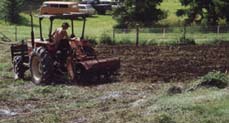 Cultivation: For poor or heavy soils (i.e. less than 1 metre of top soil and not of a sandy nature) Deep ripping is advised to improve drainage (rip to a depth of at least 45cm). The last ripping should be down the slope, as deep as possible to help sub-soil drainage. Erosion control will prevent washing out of furrows.
Cultivation: For poor or heavy soils (i.e. less than 1 metre of top soil and not of a sandy nature) Deep ripping is advised to improve drainage (rip to a depth of at least 45cm). The last ripping should be down the slope, as deep as possible to help sub-soil drainage. Erosion control will prevent washing out of furrows.
Green Manure Crops: Preparing the area three to 6 months in advance with a green manure crop will have outstanding benefits to the healthy establishment of your orchard. It has been proven that green manure cropping improv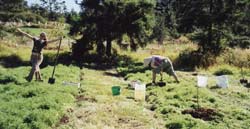 es the organic matter content of soil, prevents erosion by stabilizing the soil, improved drainage and compaction.
es the organic matter content of soil, prevents erosion by stabilizing the soil, improved drainage and compaction.
Green manure crops are most effective when the vegetative material is either tilled in or slashed and mulched approx 1 month prior to planting.
The above photo is taken while planting decidous stone fruit in autumn into soil that has been prepared one season in advance with deep ripping, cultivation and a green manure crop of cow pea (summer season). The area is covered with a green manure crop of Woolly Pod Vetch (winter season)
More information about green manure cropping, can be found at http://www.greenharvest.com.au/seeds/green_manure.htm
Drainage: Diversion drains at top of orchard site are recommended. If soil is shallow, mounding of tree rows will improve drainage as well as increase depth of topsoil.
pH: Most fruit trees will tolerate slightly acid soils (5.5 pH) However taking the opportunity, at the time of cultivation, to incorporate lime is advantageous should your pH be less than 6.5 Application rates of lime vary according to your soil type and pH. 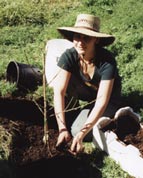
Additions: Preparing the planting area with applications of organic materials or manures prior to planting is highly recommended. The major value is that nutrients in organic matter are available over a longer period than most chemical fertilizers.
Wind break trees: are very important and should ideally be planted before fruit trees. Windbreaks should be planted along south, west and east sides of orchard, leaving the north side open.
Maintenance Schedules: It is a very good idea, in your planning phase, to develop a maintenance schedule for your trees. Schedules will help guide you in fertilizer and water applications and help you to meet the needs of your trees at the right time as well as assist you in feeling confident that your trees will be as healthy as they can be. See the following pages for some examples of fruit tree maintenance schedules.
Avocado maintenance
Citrus maintenance
Olives are undoubtedly favoured across the world for their high quality oil and 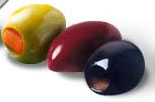 their tasty pickled fruit. It is no secret that the infamous olive has been providing food and medicine to civilizations for millenniums. With records of commercial cultivation of olives dating back more than 5,000 years. The trees themselves are capable of living more than 2,000 years entitling them to oversee not only generations but entire civilisations.
their tasty pickled fruit. It is no secret that the infamous olive has been providing food and medicine to civilizations for millenniums. With records of commercial cultivation of olives dating back more than 5,000 years. The trees themselves are capable of living more than 2,000 years entitling them to oversee not only generations but entire civilisations.
Nutrition:
The olive offers significant health benefits, including lowered cholesterol and a significant source of vitamins and minerals. The low incidence of heart disease and certain cancers in Mediterranean areas is quickly associated to their high consumption of the Olive and its oil. Pressed, filtered and bottled oil is the simplest, least processed oil available for consumption.
Olives and Cooking:
Olive oil is a scrumptious addition to pasta dishes, sauces and salads. According to tradition, to make a good salad, you need: a generous person to add the oil, a cautious person to add the salt, a miserly person to add the vinegar, a patient person to cut it and a lunatic to mix it. The virtues of bread dressed with a splash of olive oil, a sprinkle of salt, a basil leaf and a slice of fresh tomato simply cannot be denied.
Frying foods in olive oil is easy, frying WELL in olive oil is a delicious art. Fried food that is crispy and dry on the outside and tender and cooked on the inside is the objective and matching the temperature to the size of the sample is the key.
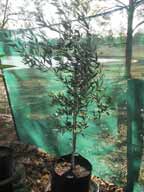 Virtues of the tree:
Virtues of the tree:
Landscape architects have long valued the appearance of the olive with its silvery grey green foliage, and its suitability for landscaping even the most difficult of sites. They are durable to strong winds, salt spray, the heat and the cold, remaining evergreen in even the nastiest frosts. They make a striking potted feature in a themed courtyard and are a hardy tree in a minimal effort orchard. They make a perfect gift as the recipient need not be a fanatical gardener to meet its needs.
Climate: Olives prefer long warm summers and cold winters.
Soils:
The tree will tolerate harsh conditions, including steep stony soils, where few other plants will survive. They do not like heavy soils that hold water for long periods of time., preferring free draining neutral to alkaline soils (optimal pH of 7.0-8.0).
Planting:
When planting one or many olives in your backyard / orchard, plant it right to begin with and the tree will go about its way for many years to come with little attention required. Planting instructions specific to Olives are simple. Prepare the site (3x3m) with one wheelbarrow load of manure and one barrow load of crusher dust. Lime may be applied at this point if necessary depending on the pH of the soil. Keep the root ball intact when planting, they don’t like being teased. Apart from that simply follow the guidelines in the corresponding article on soil preparation for orchards.
Water / Fertilizer:
Olive trees are very drought hardy but will produce much better if irrigated, especially at flowering and fruit set in late spring and during the last stage of fruit growth. They prefer fertilizer, in the form of composted manure and Rock Phosphate (crushed rock minerals), during the Autumn period, to assist with an early and strong flush. Monitoring the pH of the soil and applying lime when required is advisable. To achieve increases in pH, approximate applications of 2.4t/ha (or 2.4kg/sq m.) are suggested.
Pruning: May require skirting to 50cm above the ground and minimal pruning to shape to a central leader. 
Fruiting: Olives can take up to 7 years to fruit. They are partially self pollinating benefiting greatly by cross pollination (by wind). A 10 year old tree can be expected to bear 50-100 kg of fruit each year.
Pests and Diseases: Olives have a strong resistance to most pests and diseases. They are mildly susceptible to Black Scale (treat with white oil), Phytophthora and Anthracnose (treat with fungal copper spray).
| Frantoio / Paragon | These two selections are synonymous with each other. Of Italian origin. Highly desirable for its oil quality. Mid to late season fruiting. Prolific small fruits |
| Kalamata | Greek origin. One of the most popular pickling olives with very large fruit. |
| Barouni | Large fruit. Good for pickling, consistent cropping from a spreading tree. Good tolerance for cold winters. Mid to late season bearing |
| Manzinello | Medium sized fruit. Multipurpose (oil and pickling) Consistent high cropping. Heaviest bearing tree. |
| UC13 | Egyptian origin. Heavy bearer. Close to round fruit. Medium sized tree |
TIMES TWO
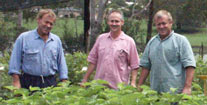 We are experiencing a strange phenomenon here at Daleys. We seem to be recruiting a high proportion of twins (or at least the progeny of twins) here at the nursery. Not only are Rick and Rodney Daley (management of the nursery) identical twins but we have just discovered that 3 of the 4 female staff at the nursery have one (or two) parents that are a twin. As two of the other staff members of the nursery are also brothers of Rick and Rodney, we have a 7:3 ratio of staff members that have twins in their family within one generation. We can only hope that this astonishing statistic somehow benefits us in consistently producing quality true to type plants with double the fruiting potential to your average tree.
We are experiencing a strange phenomenon here at Daleys. We seem to be recruiting a high proportion of twins (or at least the progeny of twins) here at the nursery. Not only are Rick and Rodney Daley (management of the nursery) identical twins but we have just discovered that 3 of the 4 female staff at the nursery have one (or two) parents that are a twin. As two of the other staff members of the nursery are also brothers of Rick and Rodney, we have a 7:3 ratio of staff members that have twins in their family within one generation. We can only hope that this astonishing statistic somehow benefits us in consistently producing quality true to type plants with double the fruiting potential to your average tree.
Increasing fertility rates in the nursery also becoming apparent, Tara left the workplace early this year to bring a beautiful baby Macy into the world and Carol (the daughter of twin father and sister of two identical twins) our propagator for the last 8 years is also expecting (twins maybe?). Evidently we pride ourselves as a consistent, efficient and productive team here at Daleys.
Photocompetition – Fruit Shoot
'Congratulations' to Diny Jansen, the winner of a of our Photocomp with his fantastic photo of the Star apple. Diny is a tropical fruit enthusiast from Childers in QLD. 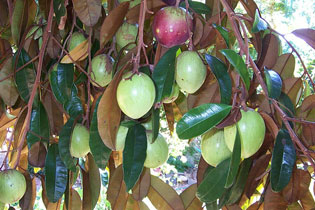
Our Plants of the Month;
Our new Exotic Fruits-
The ABIU is far from new to our range of fruit trees but it has just emerged onto our lists again after a quite period, and is well deserving of an extra bout of attention.
This fruit originates from the headwaters of the Amazon, now quite common across much of tropical South America. A long lived tree can reach up to 30m in the most favoured environment of year round warm humid conditions with moist fertile soils, however it is rarely seen above 8m in cultivation and smaller trees of 4-5m are common when grown in the subtropics.
The appealing fruit has smooth, bright yellow skin with soft creamy caramel flavoured, translucent flesh. Most often eaten fresh with a light spash of lime juice, scooping out the flesh with a spoon to avoid the latex resin in the skin.
If you have a warm protected position and can provide this tree with fertile soil and regular water, you may be blessed with fruit in as little as three years. While bearing two main crops a year in early spring and mid summer, it will often hold small quantities of fruit ripening throughout the year.
For more info see: www.hort.purdue.edu/newcrop/morton/abiu.html
CANISTEL, Pouteria campechiana
Masses of Canistels are currently falling off into the hand from our tree at the nursery entrance. Every morning of late I have been striding into the nursery with a pile of canistels gathered up in my shirt and a substantial grin. These delicious fruits have become a staple in my diet and I am feeling highly qualified to advocate their virtues.
This relative of the Abiu, also native to South and Central America is a must in any subtropical orchard. It has relatively good cold tolerance and is drought hardy once established proven by the continued resilience, with little attention, in its semi open position here in Kyogle which sunk to temperatures of -2°C during the winter. It is not too fussy with its prefered growing conditions and once established will happily produce in even the shallowest of soils. The tree can reach up to 30 m in its tropical home but is rarely seen over 8m through Australia. It features attractive velvet like branches and large evergreen leaves.
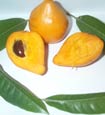 The fruit, aside from absolutley delicious, varies in shape and size from mostly round and approximatley the size of a peach to long stemmed with a tapered point at the apex. The thin skin changes from green to orange / yellow when with deep yellow mealy flesh. The flavour is very fragrant and sweet but not so sweet that it prohibits me from eating 4 or 5 in a row. The taste somewhat resembles baked sweet potato and can be used in sweet or savory dishes or consumed fresh. Please see below for this months recipe ' Canistel Pie
The fruit, aside from absolutley delicious, varies in shape and size from mostly round and approximatley the size of a peach to long stemmed with a tapered point at the apex. The thin skin changes from green to orange / yellow when with deep yellow mealy flesh. The flavour is very fragrant and sweet but not so sweet that it prohibits me from eating 4 or 5 in a row. The taste somewhat resembles baked sweet potato and can be used in sweet or savory dishes or consumed fresh. Please see below for this months recipe ' Canistel Pie
The trees listed above and many more are available at Daleys Nursery. See Bush Foods to order these plants go straight to the shopping trolley to order these plants or call in and see Emma at the Nursery for more information.
|
Canistel Pie |
|
|
Method: |
|
For more tasty canistel recipes see
http://www.ftg.org/horticulture/canistel-recipes.html
SPECIAL OFFER - Daleys now offers a Seniors Pension day every Thursday which attracts a 15% Discount from any plant purchased on presenting a seniors card.
BIG SCRUB RAINFOREST DAY
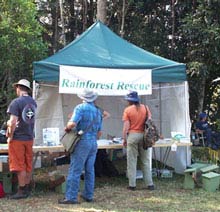 On Sunday 7th of September, Rocky Creek Dam here in Northern NSW was host to the annual Big Scrub Rainforest Day. The event now recognised as the largest Landcare information day in Australia, resembled a festival for all of the enthusiastic participants of the day. Presentations, information stalls, activities and educational walks conducted by Australia’s leading experts on the restoration of rainforests were among the days program.
On Sunday 7th of September, Rocky Creek Dam here in Northern NSW was host to the annual Big Scrub Rainforest Day. The event now recognised as the largest Landcare information day in Australia, resembled a festival for all of the enthusiastic participants of the day. Presentations, information stalls, activities and educational walks conducted by Australia’s leading experts on the restoration of rainforests were among the days program.
A number of the Staff from Daleys nursery along with hundreds of other keen rainforesters from around the region attended the day, participating in workshops such as Rainforest plant propagation, Farming and Conservation, Deep Ecology, Weed Control, Fauna protection, Indigenous Sovereignty and Genetic Diversity of our native species.
The day coincided with National Threatened species day (and of course Fathers Day) and brought attention to the current stability of the Big Scrub Rainforest. Once the largest expanse of subtropical rainforest in Australia, covering approx 75,000 hectares, it is now less than 1% of its original – a mere 300 ha of scattered rainforest fragments remain.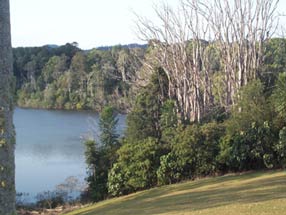
However the day was far from a sombre salutation to the faded forest, instead providing people with encouragement and optimism for the successes and developments within the bush regeneration industry. This was particularly highlighted by the surroundings as Rocky Creek Dam was previously surrounded by open dairy farm and heavily weed infested areas, following the construction of the dam and its spillways. Managed by Mr Ralph Woodford, a combination of plantations and natural regeneration over the last 20 years has brought back the rainforest and meandering through the tracks with rainforest botanists Hugh and Nan Nicholson was ultimately pleasurable as well as an excellent demonstration and educational experience.
For those unfortunate souls who were unable to attend the day, keep your ears and eyes open for the event next year!! It’s a must!!
Employment opportunities
Do you feel the nursery industry is for you?
Daleys is a dynamic family run nursery, operating for over 22 years. Together, as a team we believe that growing plants is not just an occupation but a lifestyle. We share a passion for our work and a commitment to creating a lively and progressive working environment. Scroll down to see our mission statement.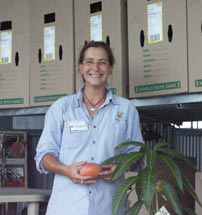
Some of the career choices available at Daleys Nursery include:
Propagation Dispatch Rainforest Plant Production Retail Customer Service Sales and Administration Marketting and Promotions General Nursery Hand
Click to view Current Positions Available
Should you be interested in other aspects of the nursery, we welcome you to send your resumes through to Management as we will keep on file for 12 months.
Send your resume now
DALEYS SHARED MISSION
"We, at Daleys Nursery, endevour to provide a professional friendly service and product that exceeds customer expectations and enhances the environment, now and into the future. We do this with integrity and a shared passion within a supportive and progressive team atmosphere, to create a holistic and successful business. "
Next Issue
Design hints for orchards
Stretching the limits - Growing in subtropicals in temperate areas
Drying your excess fruits






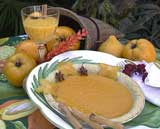 Ingredients:
Ingredients: